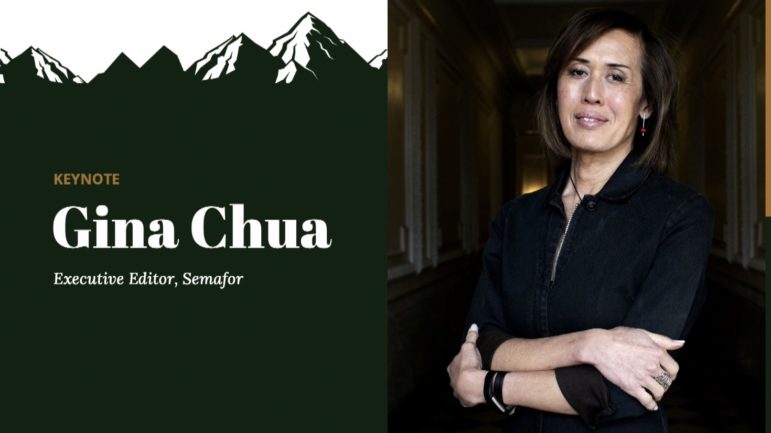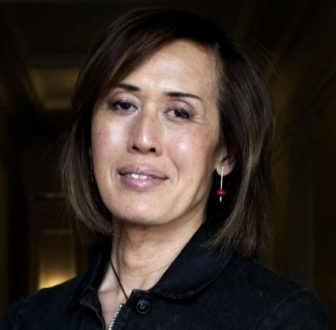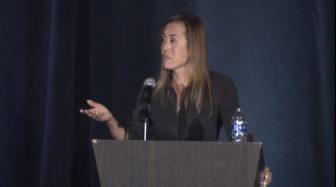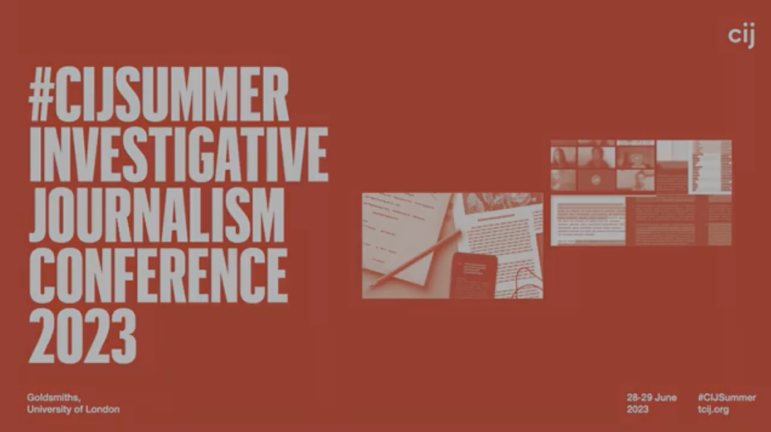

Image: Courtesy of IRE
Gina Chua on How to Reach Underserved Communities: Journalism For – Not About – Them
Editor’s note: The following keynote address was given by Gina Chua, executive editor of the new media start-up Semafor, at the awards luncheon of the 2022 Investigative Reporters & Editors conference in Denver, in the US, on June 25, 2022. It is republished here with permission. The full video of Chua’s remarks can be found at the end of this post (Chua’s speech begins around the 50 minute mark).
Thank you so much.
It’s really nice to be here, with so many of you, and seeing so many of my friends that I haven’t seen in ages — and in person! At our own super-spreader event!
And I know it’s one of those things where everyone who gets up here says they’re incredibly honored and humbled at being asked to speak to this group of amazingly accomplished investigative journalists — but, honestly, I really am.
I’ve been many things in my life — foreign correspondent, business reporter, newspaper editor, bureaucrat, bean-counter, the person who always says no, blogger, leader of technology and innovation teams. I mean, I’ve even been a guy — although, to be fair, that was just a phase.
But I’ve never been — I guess, privileged — to be an investigative journalist: this, your special tribe of muckrakers and deep diggers who, often in the face of great challenges and threats, uncover the important and uncomfortable truths we all need to know.
Sure, I’ve played my part in enabling your work — making sure you have the resources and time you need, getting editors off your back, sometimes getting them on your back, helping keep you safe, editing some of those stories — but I’ve never actually done the incredibly difficult work that you all excel at. And Roman [Roman Badanin — chief editor of Russian investigative outlet Proekt] really underscored how difficult and dangerous it really is.
So I’m grateful, I’m honored, and I’m in awe. Of the great work that you do.
Just a few examples: My old colleagues at Reuters and their ground-breaking work on qualified immunity; BuzzFeed showing China’s mass detention of Muslims; The New York Times and The Washington Post and their detailed reconstructions of January 6; and one of my favorites — you’ll see why later: The Marshall Project, AL.com, Indy Star, and Invisible Institute on the scale and scope of K-9 unit attacks on people.
You know all this matters and that you do great work. (I also know this because reporters tell me every time they want a raise). But seriously, this is an important public service: Society needs these facts uncovered, these dark corners illuminated, and few others can or will do it.
It’s critical, it’s essential, it’s necessary.
But is it enough?
We live in a world of alternative facts and mainstream conspiracy theories, of filter bubbles and a cacophony of voices, of news deserts and news overload, of algorithm-driven feeds and a torrent of misinformation.
Does it matter what we do? Do we reach the people we need to reach? And even if we do reach them, will they listen and take heed?
Unlike some others, I don’t really fear for the future of investigative journalism. Yes, it’s challenged. Yes, there are new obstacles regularly put in our way. Yes, I know there’s an arms race on skills, tools, and access to information. And I don’t want to make light of the war on journalism around the world, and especially on investigative journalism.
But I also believe in this community, in your skills, in your technology chops, in your funders, and even in business models. I’m confident we will all keep investigative journalism alive, no matter what issues and problems lie ahead.
What I fear for is the future of audiences and communities.
And after all, what is journalism for, if not to reach, and touch, and move – and serve – communities?
And so I spend a lot of my time these days thinking about what journalism is for, and who it is for.
I think it’s fair to say we’re great at content (or at least you all are) — at the digging up of truths, the presentation of facts, and the telling of stories. Sure, it’s tough work, and there’s no shortage of challenges. But it is an art we know, and one we know well.
Where I think we all could do better is not just engagement, but in reaching out to audiences — communities — who are not being served well. And that means both historically underserved groups as well as those who are being fed a diet of misinformation and hate, and who honestly see us as the enemy.
The best, most accurate, most deeply reported stories in the world will only do so much good if they aren’t being seen, or believed, by the great mass of people in any country. They are the ones who vote, who feed public opinion, who, at least in theory, drive change.
In the Philippines, 60% of the voters chose the son of the late dictator Ferdinand Marcos to be president, more than three decades after his father was ousted in a popular uprising. You know — ‘Make the Philippines Great Again’. Were they all duped? Victims of misinformation? Manipulated by social media? There was some of that, of course. OK, a lot of that.
But was it also because they lived in information voids that were filled by other narratives, revisionist histories, and visions of alternate realities?
Yes, platforms and algorithmic news feeds did some of that.
But blaming them only goes so far. What is our role? How much are we thinking about those communities, writing for them rather than about them, hearing their issues and concerns, and speaking to them and for them?
I’m not really one to talk — I’ve spent pretty much all my life in big media, and often international media, distant both from the people I’m writing about and the people I’m writing for.
But I firmly believe that trust is usually built locally, and over time, with deep engagement with local communities. And probably with new news brands too.
I suspect — fear — that polarization, and not just in this country, has become so entrenched that it doesn’t really matter what many established news organizations say: There are people that just won’t listen.
So maybe we have to reboot. Start afresh.
I’m really proud to be part of the Tiny News Collective, an initiative to help lower the barriers to starting up small, five-person community newsrooms around [the US]. Tiny is in the name, but the ambitions are big — to help seed hundreds of community-based newsrooms across the country over the next few years.
And one of the criteria is that you have to be connected to that community, and be committed to understanding their news needs and to serving them. To see what news is from their point of view, not ours.
Because let’s face it, we’re not really representative of the audiences we want to reach — whether underprivileged communities of color or MAGA cap-wearing voters.
And much as we like to think we all understand what “news” is — that we can more or less agree about what constitutes a story and what doesn’t, that there’s some quasi-objective standard of news judgment — I’m not sure that’s entirely true.
Gary Younge, a former reporter for the Guardian and now an academic in the UK, wrote a great speech (or essay, I’m not sure) that dissects what conventional news judgment is. News is what is out of the ordinary. Dog bites man: not a story. Man bites dog: story. Plane takes off: not a story. Plane crashes: big story.
Except there are two issues with that. One is that sometimes things happen so regularly — Black people are killed by law enforcement — that they are technically not out of the ordinary. But they are a story. And yet, for a long time, they were not. You only need to look at the history of journalism to see what stories were not considered stories until some seismic event — George Floyd, Harvey Weinstein — jolted us out of our complacency.
I was recently at the Columbia Journalism School Alumni weekend, and watched two members of the class of 1984 get awards. In their acceptance speeches, they talked about how, in 1984, they were discouraged from covering the AIDS epidemic while at school because some faculty members thought it wasn’t a story, or some that feared they would be typecast as LGBT-focused journalists. And about how their classmates weren’t entirely supportive of them either.
I don’t mention this to take a shot at Columbia — it’s a great school, and I’m a proud alumnus (Go class of 88!) — but to note that some very smart people, at the top of our profession, didn’t see an obvious, in retrospect, story in front of their eyes. They weren’t stupid, and neither are we. So: What are we not seeing? What are our blind spots? What is the AIDS epidemic that we aren’t seeing?
After all, even dogs biting men can be a story, as The Marshall Project and others proved last year.
The other issue — and it’s reflected a bit in that anecdote about AIDS — is that even when news is what’s out of the ordinary, what’s out of the ordinary for one person is not the same as for another person.
I probably see the world differently from you, and what’s news to me may not be news to you, and vice versa. Not right, not wrong, just different. We almost certainly have different experiences, values, concerns.
Although, if there’s another trans woman from Singapore out there in the audience, we should catch up and share notes. Maybe we agree on everything.
But however many different and valid views and viewpoints there are, newsrooms can only pursue so many stories. Who decides which ones? Well, we know. It’s senior people in the newsroom. And what’s newsworthy — unusual — to them is generally influenced by their experience and their life.
And for too long, the leadership of the industry as a whole — and this particular part of it as well — has had different lives and experiences from their audiences. And this is why diversity matters, and especially diversity in management.
We need more perspectives, different experiences, to bring to bear on that critical, basic question of what is a story? What matters?
I want to give a shout out to the Women of NICAR, which has done a tremendous job in nurturing a generation of female data journalists, and the Ida B. Wells Society, which is working to increase the number of investigative journalists of color.
Having those different voices at the table — the top table — really makes a difference.
And yet: It’s also not enough. We can’t simply depend on diverse members of staff — assuming we have any — to represent their communities. That’s not fair to them, to their communities, or to their news organization.
I’m much more sensitive to trans issues than most; that makes sense. But Semafor — or Reuters — can’t count on me to know everything about every trans issue, represent every view or even any view that the community holds. I’m not representative of Singapore, too. Or of people who think — who know — that Battlestar Galactica is the Best. Show. Ever. No one can be. All communities are big tents.
Representation matters, for its own sake. But we can’t and shouldn’t depend on it to solve broader questions of news judgement and sensitivity. We need to train our newsrooms to be more aware about where we’re making assumptions, where we need to ask more questions, where we should examine our biases.
One very basic, minor example: There was a lede in a story, from a news organization that will remain nameless, that said something like: ‘China launched a rocket carrying five astronauts, including two women, to a space station.’
If you can’t figure out what’s wrong with that sentence, then you definitely need that training. (Or you can just ask the woman sitting next to you. She’ll tell you.)
That may be minor, even trivial. But it begs the bigger question: What biases do we have that we don’t recognize? What stories aren’t we seeing? What concerns are we missing? Or even, how are we framing our stories or the issues? Wendi Thomas, the founder of MLK50: Justice through Journalism, has a wonderful line: “What if we didn’t see poverty as a condition, but as a crime? How would that affect our coverage and our storytelling?”
There was research done some time back on stories submitted for IRE awards, and on how disparity was framed in them — usually as a deficit for minority communities rather than as a gain by majority communities. You know: Hispanics are X percent poorer than some other population. But, if I write about a robbery, do I say the victim is now ten percent poorer than the robber, or that the robber took ten percent of her money? I don’t know what the right answer is, but I think it’s worth asking the question. It’s worth being intentional.
And in that vein: There was an interesting quote in a New York Times story a little while back that basically said, if we write a sentence that says, “Black people are usually denied loans by banks,” the logical question is to ask how we can help Black people. If, on the other hand, we write, “Banks often deny loans to Black people,” our question is much more likely to be “What’s wrong with banks and what should we do about them?”
All of which is a very, very long way of saying words matter, frames matter, news judgment matters, and mostly communities — and their interests, not ours — matter.
Maybe this sounds depressing, or that we’re somehow failing. It’s not meant to be, and we’re not. We have great opportunities and missions and futures ahead of us — if we seize them.
There are so many people so underserved by news and the news industry, all around the world. What a market opportunity! Who better to reach them than some of the best muckrakers, storytellers, communicators, and public-spirited people in the world? You. In this room.
Words and facts matter. And you are all masters of those.
I went to an all-boys Catholic grade school, so I’m used to invocations.
So you’re getting one: May you find the stories that matter to more communities. That reach across divides. That touch hearts and change minds.
May you tell the stories that move people. And move them to action.
No pressure.
Again, thank you so much for having me, and for letting me be, for this brief moment, one of you. Thank you.
Watch the full video of Chua’s speech below (her remarks begin at the 49:50 mark).
Additional Resources
Sometimes Dog Bites Man Really Is the Story – And We Keep Missing it
How Collaboration Enables Transcendent, World-Changing Journalism
Bridging the Gap: Rebuilding Citizen Trust in the Media
 Gina Chua is the executive editor of the new media start-up site Semafor. Previously, she was the executive editor at Reuters, editor-in-chief of the South China Morning Post, and editor of The Wall Street Journal’s Asia edition. A native of Singapore, Gina transitioned in late 2020, making her one of the most senior transgender journalists in the industry.
Gina Chua is the executive editor of the new media start-up site Semafor. Previously, she was the executive editor at Reuters, editor-in-chief of the South China Morning Post, and editor of The Wall Street Journal’s Asia edition. A native of Singapore, Gina transitioned in late 2020, making her one of the most senior transgender journalists in the industry.











